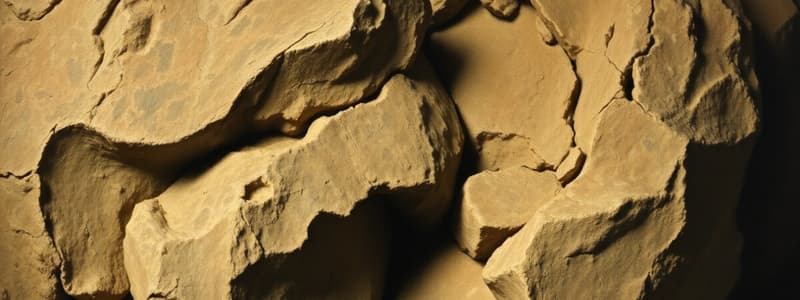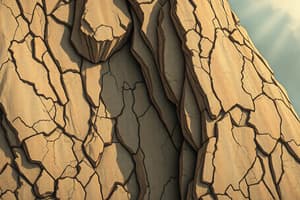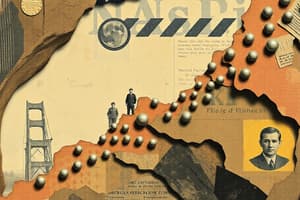Podcast
Questions and Answers
What happens to rocks when they are exposed to stress?
What happens to rocks when they are exposed to stress?
- They undergo deformation. (correct)
- They become completely rigid.
- They become smoother.
- They remain unchanged.
Which type of stress involves rocks being stretched apart?
Which type of stress involves rocks being stretched apart?
- Compressional stress
- Tensional stress (correct)
- Shear stress
- Incompressional stress
What is elastic deformation?
What is elastic deformation?
- A permanent increase in size.
- A change that leads to fracturing.
- A reversible change in shape. (correct)
- An irreversible change in shape.
In which stage of deformation do rocks become permanently altered in shape?
In which stage of deformation do rocks become permanently altered in shape?
What occurs during shear stress?
What occurs during shear stress?
What is the final stage of rock deformation when rocks can no longer return to their original form?
What is the final stage of rock deformation when rocks can no longer return to their original form?
What determines a rock's ability to handle stress?
What determines a rock's ability to handle stress?
Which analogy best represents ductile deformation in materials?
Which analogy best represents ductile deformation in materials?
What is the primary difference between ductile and brittle rocks?
What is the primary difference between ductile and brittle rocks?
How does temperature affect the flexibility of rocks?
How does temperature affect the flexibility of rocks?
Which of the following materials is considered ductile?
Which of the following materials is considered ductile?
What effect does water content have on the brittleness of rocks?
What effect does water content have on the brittleness of rocks?
What happens to wet clay when it is baked in a kiln?
What happens to wet clay when it is baked in a kiln?
What is an example of a brittle rock?
What is an example of a brittle rock?
Which of the following statements about rock deformation is incorrect?
Which of the following statements about rock deformation is incorrect?
Flashcards
Rock Stress
Rock Stress
Forces that cause rocks to change size or shape.
Tensional Stress
Tensional Stress
Stress that stretches rock apart.
Compressional Stress
Compressional Stress
Stress that squeezes rock together.
Shear Stress
Shear Stress
Signup and view all the flashcards
Elastic Deformation
Elastic Deformation
Signup and view all the flashcards
Ductile Deformation
Ductile Deformation
Signup and view all the flashcards
Fracture
Fracture
Signup and view all the flashcards
Rock Elasticity
Rock Elasticity
Signup and view all the flashcards
Ductile Rock
Ductile Rock
Signup and view all the flashcards
Brittle Rock
Brittle Rock
Signup and view all the flashcards
Rock Flexibility
Rock Flexibility
Signup and view all the flashcards
Stress on Rocks
Stress on Rocks
Signup and view all the flashcards
Temperature and Rock
Temperature and Rock
Signup and view all the flashcards
Water and Rock
Water and Rock
Signup and view all the flashcards
Rock Deformation
Rock Deformation
Signup and view all the flashcards
Study Notes
Rock Stress and Deformation
- Rocks experience stress, causing deformation (changes in size or shape).
- Different types of stress lead to different types of deformation.
Types of Stress
- Tensional stress: Rocks are stretched apart.
- Compressional stress: Rocks are pressed together.
- Shear stress: Rocks slip horizontally in opposite directions.
Stages of Deformation
- Elastic deformation: Reversible change in shape or size.
- Ductile deformation: Irreversible change in shape; rock can be molded.
- Fracture: Irreversible breaking of the rock.
Rock Responses to Stress
- Rock's ability to handle stress: Depends on elasticity (flexibility) of the rock material and temperature.
- Ductile rocks: Flow in response to stress; examples include clay and certain minerals.
- Brittle rocks: Break or fracture in response to stress; examples include quartz and feldspar.
- Influence of temperature: Higher temperature = more ductile; lower temperature = more brittle.
- Influence of water content: Lower water content = more brittle; Higher water content = more ductile.
- Rocks react differently to stress depending on their specific material. Wet clay is easy to mold, but dry clay is brittle. Cement is moldable when wet, but brittle when dry.
Studying That Suits You
Use AI to generate personalized quizzes and flashcards to suit your learning preferences.




